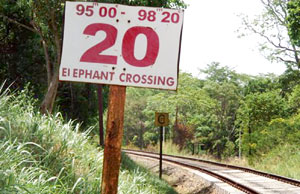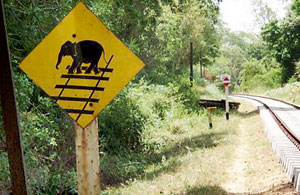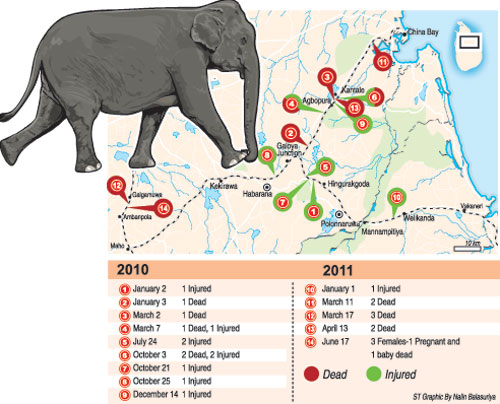Young and feisty, the world was at her feet. It was a nightly journey she had made many times with her mother, aunts, sisters and cousins. The second night after Poson was no different and Thushari, her mother and a baby relative, climbed up the embankment as they had done on numerous occasions, when out of the gloom thundered unexpected danger.
With a mighty roar, ripping the stillness of the night, shaking the very ground, tearing around the corner came what must have appeared a demon. Terrified by the ear-splitting blaring of the horn and transfixed in the blinding headlight of the train relentlessly bearing down on them, Thushari and her baby cousin may not even have realized what hit them, most probably dying instantly after being knocked down by the train. But Thushari’s mother struggled around in a ditch alongside the track, bleeding profusely in the gut-wrenching agony of death not only of herself but also the 18-month baby she was carrying.
 |
| The area where the
tragedy occurred |
 |
Even as in human homes in Galagedera people mourned the six Poson pilgrims who died on the morn of Friday, the 17th, when their trishaw was mangled up on collision with a tipper at Mawathagama, the same night a herd of elephants lamented the death of Thushari and the others between Galgamuwa and Ambanpola.
One athinni (cow elephant) didn’t leave the spot for a long time and had to be chased away, early the next morning, said P. Padmathilake who runs a boutique with healthy food such as kola kenda by the side of the railtrack. He was one of the first on the scene, flashing a torch, soon after this elephantine disaster.
The athinna who wouldn’t leave the side of the baby may have been her mother, says Padmathilake, explaining that each night about 30 elephants cross from this point, going past his kade, “saththam dada” (threatening him). He and his boutique have never been attacked, he hastens to add, and he would say a quick prayer as they went past.
Egollo denan hitiya koi welawateda kochchiye yanne kiyala. Me kochchiye special ekak, says Padmathilake, explaining that the elephants knew what time the train would go past, but this death-dealer of a train was a special one.
Thushari was about nine years old, says Dr. Prithiviraj Fernando of the Centre for Conservation and Research who knew her well because he had fixed a radio collar in collaboration with the Department of Wildlife Conservation (DWC) on this young female whose movements they were tracking as part of an initiative to conserve elephants and mitigate the human-elephant conflict.
Thushari who was part of a 50-odd herd generally followed a certain lifestyle. During the dry season, around this time, they would spend their days in the Galgamuwa teak plantation and forests along the Mee Oya, but at night, cross the road and climb up the embankment which is about 10 feet high, to cross the railtrack, amble down the embankment on the other side to graze in the uncultivated paddy fields.
During the Yala season, only part of the huge tract of paddy adjoining the railtrack would be cultivated and the elephants would graze in the fallow areas and get back to the teak forest early morning, says Dr. Fernando.
Ironically, where this elephant tragedy took place, the Sunday Times understands, is squarely between signboards indicating ‘elephant crossing’ with clear instructions that the speed limit should be 20km per hr. The signboards had been put up after a similar tragedy with the deaths of another three elephants a few years ago a few hundred yards further away.
Thushari’s herd crosses the railtrack in the night and early morning before and after the daily night-mail trains. They were probably familiar with the daily schedule of the night mail around 1.30 a.m.
But what Thushari and her relatives did not realize on that fateful Friday night was that a ‘special’ train for Poson pilgrims would bear down on them in the darkness at about 11.30, just as they crested the embankment to cross the track.
With conservationists urging that the DWC needs to identify common elephant crossing areas and work with the Department of Railways to enforce a speed limit and the latter in turn should ensure full cooperation, the scene between Galgamuwa and Ambanpola was a sad one on June 18.
Paansakula having been administered and a backhoe digging the pits for the graves, it was farewell time not only for Thushari on the threshold of youth, a baby and another in the prime of her life, but also for a tiny life which was over even before it had begun.
Warning signs and
speed limits
We have erected 100 luminous signboards in association with the Railway Department in the Habarana-Trincomalee and Anuradhapura-Galgamuwa area, warning train drivers of elephants crossing the track but some are rusted, DWC Director-General Dr. Chandrawansa Pathiraja said, assuring that they will re-do them and hand over to the railways for erection once again.
The Railway Department has also assured us that the speed limit will be followed strictly, he added, explaining that special stretches where elephants usually cross will be checked out and bends cleared with the help of NGOs to minimize these tragic deaths.
However, if a tragedy repeats itself within a sign-posted location, what good is putting up boards and assurances of adhering to speed limits, question conservationists.
After the tragedy
Conceding that it was a national tragedy, a Railway Department source assured that an inquiry is being held into the June 17 accident.
He requested that the Sunday Times await the inquiry report, when asked whether the train driver was speeding, in violation of the 20 km per hr speed limit or was drunk.
Scientists allege that if the train was indeed following the speed limit of 20km set by the Railway Department itself, it is not possible for this tragedy to have occurred as the elephants would have got out of the way of the approaching train.
Meanwhile, the Railway Department source pointed out that there was an agreement between the two departments that two wildlife officials would be on trains especially between Kekirawa and Palugaswewa to help prevent elephant deaths in train accidents.
However, the practicality of such an arrangement has been questioned by conservationists. Can the DWC with its severely limited staff and resources afford to have officers allocated to each train on a daily basis? What would the DWC officer do that the train driver could not? Especially when crossing points have been identified and sign-posted, does it require another person from another department to ensure that rules are adhered to, they ask.
The Railway Department has also cautioned the drivers, assistant drivers, head-guards and under-guards to be careful, according to the Railway Department source.
Awareness workshops had been held in association with the DWC for railway staff regularly up to three years ago at Minneriya but not after that. These workshops would be revived on a priority basis, he added. |




